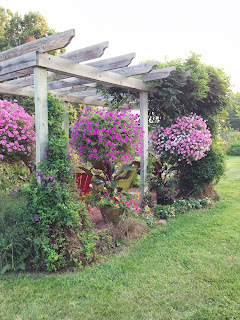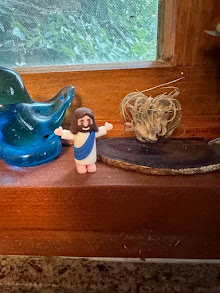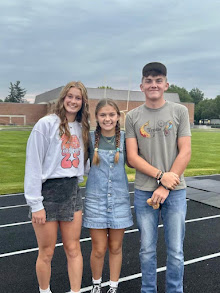I had never seen anything like it and, after all these years, still haven't. I asked my parents what on earth the vine was smothering the trees in leafy abundance and streamers of lavender blossoms strung like a lei. The vine romped along the tree tops and strained the verticality of the electric pole supplying the pump house for the well. The farm house was long empty and the farm stead had been abandoned to the persimmons, the sassafras, the mulberries and other early invaders of unmown central Missouri land...but even a novice like me could tell the monster in the trees was no newcomer. My father has taken on many an unkempt landscape in his time, cedars, honey locusts, multiflora roses, and restored them to the pastoral design envisioned in his mind, but he could recognize and appreciate a force of nature akin to a volcano, a redwood, the tide, or a prairie wildfire.
 |
| This is the general idea but a mere echo of the vine I recollect |
Not all wisteria is the blooming equivalent of kudzu. Across from my parent's house in Jefferson City was a different breed of the plant, tamed, structural, sculptural. With a twisted trunk like a Monterey cedar and a mop of bloom like a Japanese cherry on 'roids, the standard was clearly a human contrivance, but still evinced a sturdiness beyond the brick and mortar of the neighborhood.
 |
| Again, alas, not the exact specimen, which was broader, taller and trimmed into a bowl cut by its caretaker. |
 |
| Blake making sure it is true; Ann making sure Aaron doesn't eat any dirt |
 |
| Ben on the business end of the spade; Aaron using more primitive means. |
Perhaps I exaggerate, but it seems to me that it rained an inch a week the summer of 2004. At least my photos from that summer reveal a lush green landscape with flowers that rival the gardens in Martha Stewart and other fictitious constructions. Speaking of construction, I decided our backyard needed a "focal point", something to look toward from back door or the second floor.
Blake said he would build me a pergola...a shade structure under which we could sip cool beverages, read weighty tomes and have civilized discussions. Or....at the very least, rest our eyes.
With Ben's help and the sacrifice of several hours of weekend, we soon had a structure. Now...all we needed was the shade.
I had a dream......
Easier said than done....
We bought a whole baker's dozen of clematis later that summer. They have bloomed faithfully every year, creating pillars of blue violet or fountains of sky blue or occasional winsome stars of pale pink depending upon their vigor and character. But nary a one has ventured as far as the rafters. None have provided actual shade.
Each year I hang massive mossy bowls of blooms in the 'windows' of the structure. It is more than sturdy and bears the burden of 20"moss baskets without failure. These big balls are worth the daily trips dragging the hose out to water, but they suspend between heaven and earth...not above.
 |
| Summer 2013 |
Finally, one of the employees at the Lincoln Earl May sent Blake home with a broken wisteria in a 2 gallon pot. Every once in a while we've gotten bonus plants like that: alive but damaged and unsalable. Hey, what the heck? What was the downside? Who turns down a freebie?
Let me tell you what I already knew about wisteria. In addition to my past observations.
- Wisteria is sold two ways: Either as a young plant grafted on an older rootstock, or grown from seed on its own roots and stem. Garden experts point this out because a seed raised wisteria can a)be variable in color and b) can take up to twenty years to flower from seed. (!)
- Wisteria is very long lived. Consequently, choose wisely. Be certain your grandchildren will bless and not curse you. Beware lest your garden structure prove inadequate to the task of supporting the kind of vegetation that surrounded Sleeping Beauty's castle.
So....we waited. And the vine grew. Kind of. To be truthful, it didn't actually grow. It just didn't quite die all the way. Each spring a tendril would eventually sprout from the twisted gray stem. It wended its way through the much larger and impressive clematis. And that was it.
Then, four years ago, the wisteria made it to the rafters by the end of the summer. And three summers ago, it produced a number of blossoms in the spring. And two summers ago, it began to weave an impenetrable curtain of glossy leaves across the northwest quadrant of the shade structure.
And this summer? This summer I bought two colorful Adirondack chairs to set between the pots of banana among the moss baskets of wave and Vista petunias. Because THIS summer, a good solid quarter of the pergola rafters are green leafy ceiling, home to robins and mourning doves and buzzing bees. A person could almost feel secluded, nestled out there.
Wisteria is not a passing fancy, a flirtation, a whim, like a fad diet or new pair of shoes. The reward comes many years after the initial investment. Wisteria is more like a retirement plan than day trading. It requires the type of patience that is measured in decades. And if you are willing and able to grow those kind of roots, you can grow old reveling in the amazing juxtaposition of the freshest of lavender blossoms with a trunk the hue and texture of elephant skin.
Patience, grasshopper. Wait....




















No comments:
Post a Comment